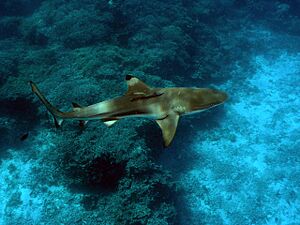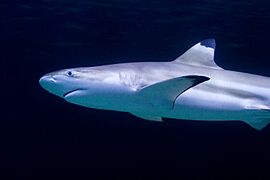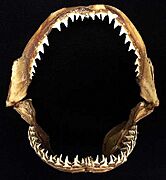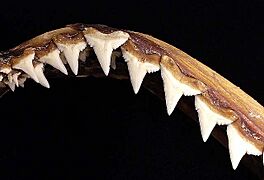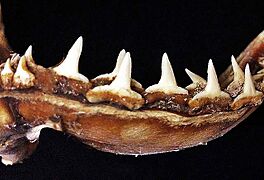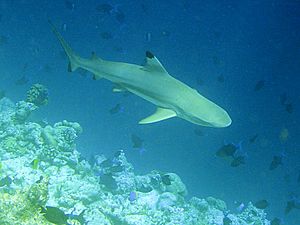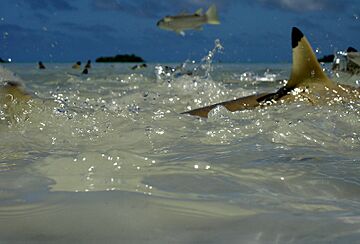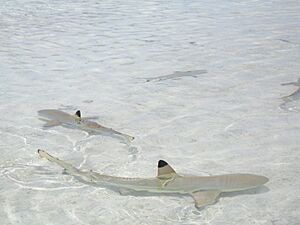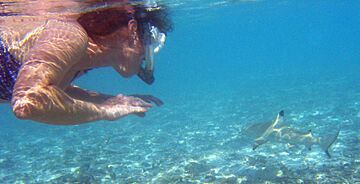Blacktip reef shark facts for kids
Quick facts for kids Blacktip reef shark |
|
|---|---|
 |
|
| Conservation status | |
| Scientific classification | |
| Genus: |
Carcharhinus
|
| Species: |
melanopterus
|
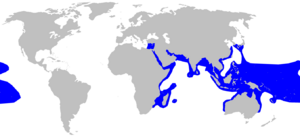 |
|
| Range of the blacktip reef shark | |
The blacktip reef shark (Carcharhinus melanopterus) is a type of requiem shark. You can easily spot it by the clear black tips on its fins, especially on its first dorsal fin and caudal fin (tail fin). These sharks are very common in the warm, shallow waters of coral reefs in the Indian and Pacific Oceans. They love shallow areas close to shore.
The blacktip reef shark usually stays in the same local area for many years. It is an active predator that hunts small bony fish, cephalopods (like squid), and crustaceans (like crabs). Sometimes, they even eat sea snakes and seabirds. Like other sharks in its family, the female blacktip reef shark gives birth to live young, usually two to five pups at a time. Newborn sharks are found in very shallow water, often swimming in large groups.
These sharks are generally shy and hard to get close to. They usually do not bother humans unless they are attracted by food. However, people wading in shallow water might get their legs accidentally bitten, as the shark might mistake them for prey. Blacktip reef sharks are sometimes caught for their meat, fins, and liver oil. The International Union for Conservation of Nature (IUCN) lists the blacktip reef shark as a Vulnerable species. This means their numbers are decreasing in some places due to too much fishing.
Contents
About the Blacktip Reef Shark
French naturalists Jean René Constant Quoy and Joseph Paul Gaimard first described the blacktip reef shark in 1824. They named it Carcharias melanopterus. The name comes from Greek words: melas means "black" and pteron means "fin". This name clearly describes the shark's black fin tips.
Later, scientists moved this shark into the genus Carcharhinus. This is why its scientific name is now Carcharhinus melanopterus. Other common names for this shark include blackfin reef shark and reef blacktip shark.
Where Blacktip Reef Sharks Live
The blacktip reef shark lives in the warm, tropical and subtropical waters of the Indo-Pacific region. You can find them from South Africa all the way to the Red Sea, including places like Madagascar and the Maldives. In the Pacific Ocean, they live from southern China and the Philippines to Indonesia, northern Australia, and many islands like Hawaii.
Even though they can be found as deep as 75 m (246 ft), blacktip reef sharks usually stay in water only a few meters deep. You can often see their dorsal fins sticking out of the water close to shore. Younger sharks like shallow, sandy areas. Older sharks are more common around reef edges. These sharks have also been seen in brackish water (a mix of fresh and salt water) and even in freshwater in some places.
What Blacktip Reef Sharks Look Like
The blacktip reef shark has a strong body and a classic "shark" shape. It has a short, wide, rounded snout and fairly large, oval eyes. Each nostril has a small flap of skin.
The pectoral fins (side fins) are large and shaped like a sickle. The first dorsal fin (top fin) is tall with a curved back edge. It starts right above the pectoral fins. The second dorsal fin is smaller and sits opposite the anal fin (bottom fin near the tail). There is no ridge between the two dorsal fins.
This shark is pale grayish-brown on top and white underneath. It has a clear white band along its sides. All its fins have black tips with lighter borders around them. These black tips are very noticeable on the first dorsal fin and the lower part of the tail fin.
Most blacktip reef sharks grow to about 1.6 m (5.2 ft) long. Some rare individuals can reach 1.8 m (5.9 ft) or even 2.0 m (6.6 ft). The heaviest blacktip reef shark ever recorded weighed 13.6 kg (30 lb).
Life and Behavior
The blacktip reef shark is one of the most common sharks on coral reefs in the Indo-Pacific. It swims fast and is very active. You might see them alone or in small groups. Sometimes, large groups of these sharks gather together.
Blacktip reef sharks tend to stay in specific areas for several years. A study found that they have a small home range, about 0.55 km2 (0.21 sq mi). This is one of the smallest home ranges for any shark species. They spend most of their time swimming back and forth along reef ledges. They also make short trips onto sandy areas.
Young blacktip reef sharks can be eaten by larger fish, such as groupers, grey reef sharks, and tiger sharks. Even other blacktip reef sharks might eat them.
What They Eat
Blacktip reef sharks are important predators in their ocean homes. They mostly eat small bony fish, like mullet, groupers, and wrasses. Groups of blacktip reef sharks have been seen working together to herd schools of mullet towards the shore. This makes it easier for them to catch the fish.
They also eat squid, octopus, cuttlefish, and shrimp. Sometimes, they will eat dead animals or smaller sharks and rays, but this is rare. In northern Australia, they are known to eat sea snakes. Sharks near Palmyra Atoll have even been seen eating seabird chicks that fall into the water from their nests.
Blacktip reef sharks can find prey using their excellent sense of smell and by detecting electricity. They can sense small objects up to 3 m (9.8 ft) away. Like most sharks, they don't see colors well, but their vision is great for spotting movement in low light. When many blacktip reef sharks are together, they can become more excited and confident, sometimes leading to a feeding frenzy. They might hunt more at night than during the day.
Shark Babies
Blacktip reef sharks give birth to live young. The details of their reproduction can vary depending on where they live. For example, off northern Australia, they mate every year. In other places, they might mate every two years.
When a female shark is ready to mate, she swims slowly near the bottom. Male sharks are attracted to her, possibly by chemical signals she releases. The male might bite the female's fins during mating, but these wounds heal quickly.
The pregnancy period is usually 10–11 months long in the Indian Ocean and Pacific islands. Off northern Australia, it's about 7–9 months. Females have two uteruses, each holding separate embryos. The embryos first get food from a yolk sac. Later, a placenta forms, connecting the embryo to the mother's uterine wall.
Births happen from September to November. Females use shallow nursery areas inside the reef to give birth. Newborn pups are usually 40–50 cm (16–20 in) long. A litter typically has 2–5 pups, often 4. Young blacktip reef sharks often form large groups in very shallow water over sand flats or in mangrove swamps. They grow quickly at first, then their growth slows down as they get older. Males and females are ready to mate when they reach about 95 cm (37 in) to 110 cm (43 in) in length.
Blacktip Reef Sharks and Humans
Most of the time, blacktip reef sharks are shy and will swim away from people. However, because they live in shallow waters, they often come into contact with humans. They are considered potentially dangerous.
As of early 2009, there were 11 unprovoked attacks and 21 total attacks linked to blacktip reef sharks. None of these attacks were fatal. Most attacks happen when sharks bite the legs or feet of people wading in shallow water. The shark likely mistakes the person's legs for its natural prey. These bites usually do not cause serious injury. In the Marshall Islands, local people avoid bites by swimming instead of wading in shallow water. This makes them less like a potential meal. Blacktip reef sharks can also become aggressive if there is bait in the water, especially if they try to steal fish caught by spear fishers.
Blacktip reef sharks are caught by local fisheries in places like Thailand and India. However, they are not a main target for commercial fishing. Their meat, liver oil, and fins are used. The International Union for Conservation of Nature (IUCN) has listed the blacktip reef shark as Vulnerable. This means their numbers are going down. Even though they are still common in many areas, too much fishing has caused their populations to drop in several locations. Since these sharks do not have many babies, it is hard for their populations to recover quickly.
Blacktip reef sharks are popular in public aquariums. People enjoy seeing them because they look like a "typical shark." They are also a draw for ecotourism divers who want to see sharks in their natural habitat.
See also
- Oceanic whitetip shark and Whitetip reef shark – other types of sharks known for the colors on their fin tips.



